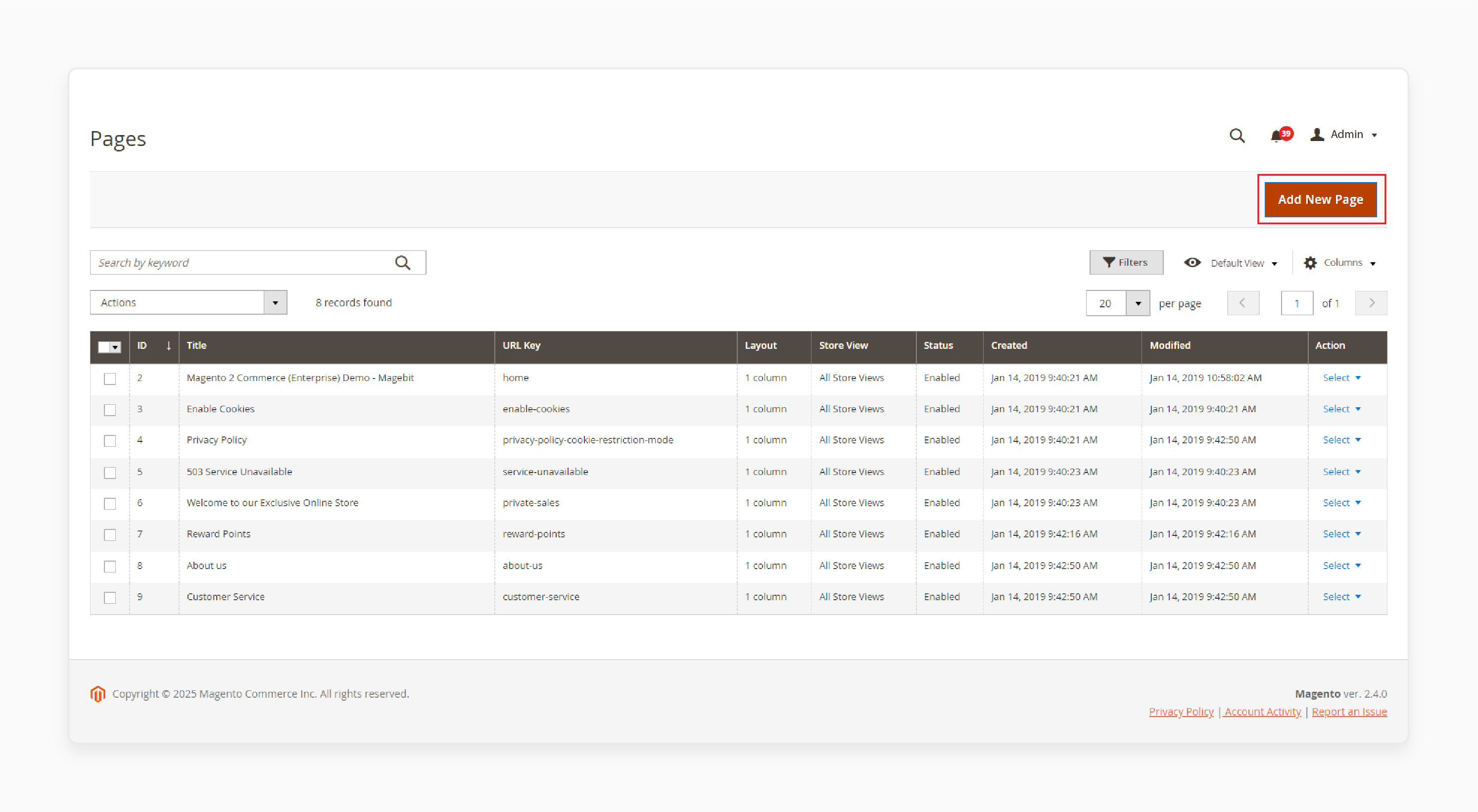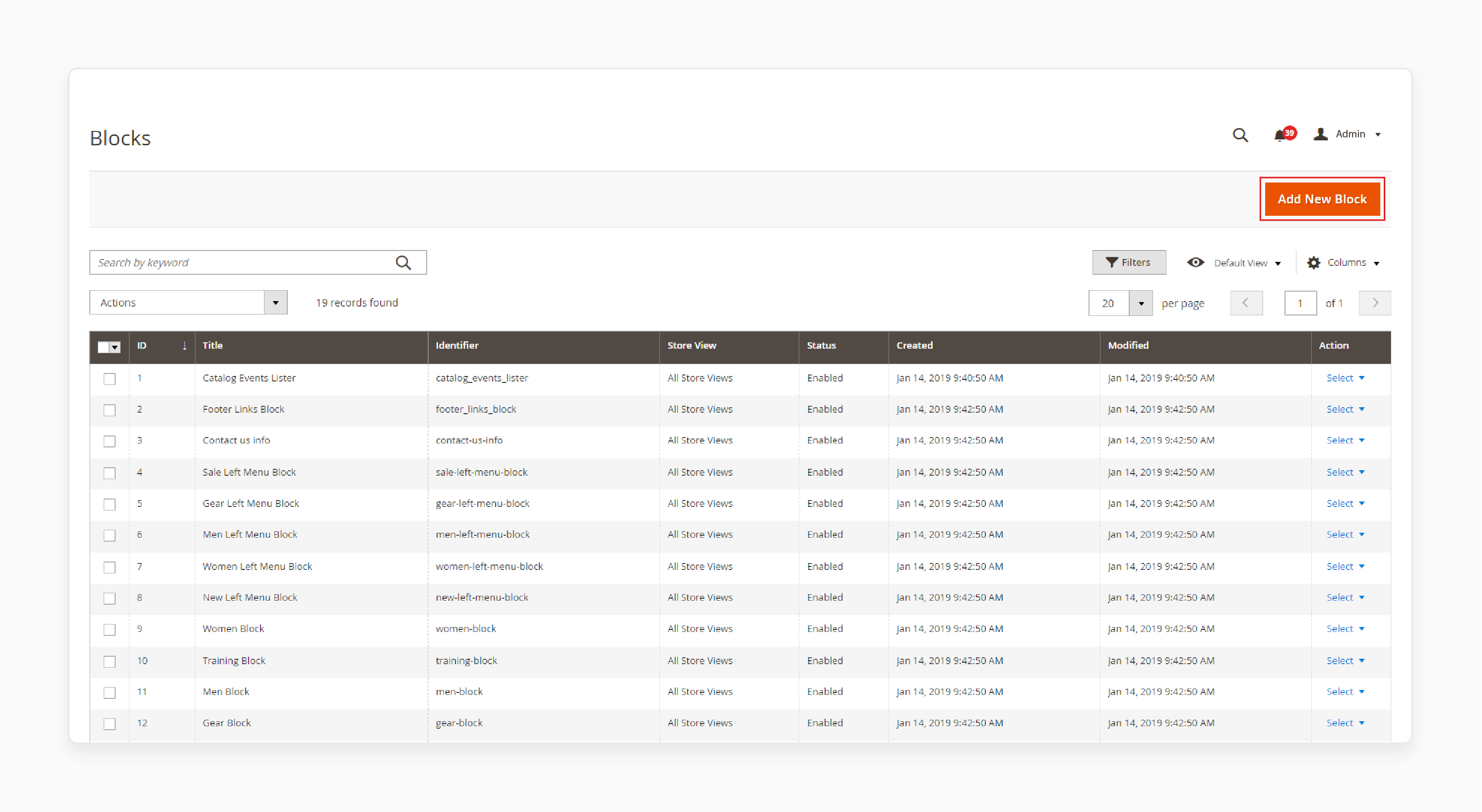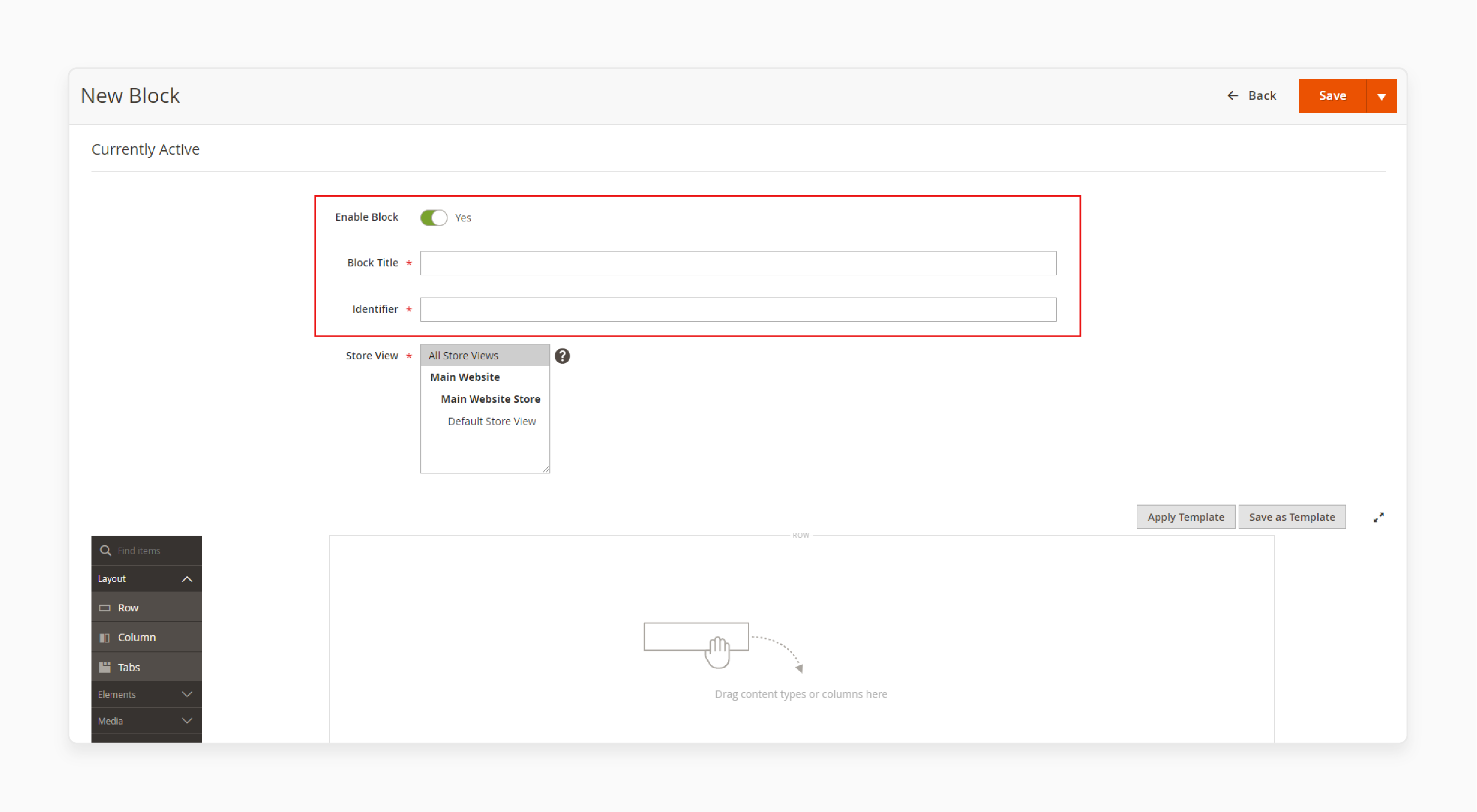
Steps to Create and Manage Magento 2 Content Management
Looking to optimize your website's content for better engagement? Magento 2 content management helps you organize and maintain dynamic content with ease.
In this tutorial, we will explore the key components and configuration steps of Magento 2 content management.
Key Takeaways
-
Magento 2 CMS simplifies website content management.
-
Drag-and-drop page building helps build easy design.
-
The WYSIWYG editor simplifies content creation.
-
Static blocks help save time with reusable content.
-
Schedule content for timely promotions and updates.
What is Magento 2 Content Management?
Magento 2 content management is a feature-rich system that helps eCommerce businesses create, edit, and manage website content with ease.
The content management system allows users to format text, images, and media without coding. Static blocks and widgets let store owners add reusable content and dynamic elements. These include banners and sliders.
Magento 2 also provides SEO tools to optimize metadata and URLs for better visibility. The user-friendly system enables businesses to build engaging and search-optimized websites. It helps enhance the customer shopping experience.
Key Components of Magento 2 Content Management
1. Drag-and-Drop Page Builder
-
It is one of Magento 2’s standout features. It empowers users to create visually appealing pages without writing a single line of code.
-
You can add various elements like:
1. Banners
2. Videos
3. Text
4. Images
-
It is done by simply dragging and positioning them within the layout.
-
Real-time editing capabilities allow you to preview changes instantly. It also helps reduce the time and effort required for designing pages.
-
The feature is particularly useful for creating promotional layouts and product displays.
2. WYSIWYG Editor
-
The "What You See Is What You Get" WYSIWYG editor simplifies content editing for users. It is done with minimal technical expertise.
-
The intuitive interface allows you to:
1. Format text
2. Insert images
3. Embed videos
4. Create hyperlinks
-
Advanced users can switch to HTML mode for custom coding. The tool is perfect for editing product descriptions and managing online store content effectively.
3. Customizable Templates
-
Magento 2 provides pre-designed templates to speed up the creation of pages. It ensures consistency across the website.
-
These templates can be tailored to fit your brand’s identity by modifying elements like:
1. Fonts
2. Colors
3. Layouts
-
They simplify the process of building product pages and category pages. Custom templates ensure a cohesive user experience and professional look throughout the store.
4. Static Blocks
-
It allows you to create reusable content elements such as:
1. Banners
2. Promotional messages
3. Footers
-
These blocks can be updated centrally. It helps save time when changes need to be reflected on multiple pages.
-
For example, a seasonal promotion banner added to a static block will automatically update across all assigned locations. It ensures efficiency and consistency.
5. Dynamic Widgets
-
Widgets provide a way to add dynamic, interactive content to your site like:
1. Sliders
2. Product recommendations
3. Promotional banners
-
They enhance user engagement by showcasing relevant and personalized content. It is based on customer behavior or preferences.
-
Widgets are highly flexible and can be placed in different areas of your store. It helps improve the overall shopping experience.
6. SEO Optimization Tools
-
Magento 2 includes built-in tools to help optimize your site for search engines. You can easily:
1. Add metadata
2. Optimize URLs
3. Include focus keywords for pages and categories
-
The platform also supports XML sitemaps and canonical tags to avoid duplicate content issues.
-
It helps improve your site's SEO performance and boost visibility on search engines.
7. Media Library Management
-
Magento 2 includes a centralized media library for storing and organizing images and videos.
-
You can reuse these media files across multiple pages and content blocks. It helps ensure consistency and saves storage space.
-
The media library also includes tools for optimizing images. It helps reduce load times and improves overall site performance.
8. Content Scheduling
-
The content scheduling feature allows you to plan and automate the publishing of content.
-
You can set start and end dates for banners or entire pages. It helps ensure your content aligns with marketing campaigns.
-
The feature eliminates the need for manual updates. It also enables you to focus on other aspects of your store.
How to Create and Manage Content in Magento 2?
1. Log in to the Magento Admin Panel with the appropriate credentials.
2. Go to Content > Pages.
3. Click on Add New Page and enter essential details such as page title, URL key, and metadata.

4. To create a new block, go to Content > Elements > Blocks in the Magento Admin Panel and click on Add New Block.

5. Once you name and enable the block, use the WYSIWYG editor to customize its content.

6. Define the block's position using XML or widgets. Magento 2 allows precise placement of Magento 2’s CMS blocks on existing pages or within product and category areas.
Common Challenges and Solutions for Magento 2 Content Management
1. Managing Complex Layouts
Creating complex layouts with multiple dynamic elements can be overwhelming for non-technical users.
Solution:
-
Use the page builder tool for drag-and-drop customization.
-
Use pre-designed templates to simplify layout creation. Consult the Magento user guide for additional assistance.
2. Slow Page Loading Times
Heavy media files and unoptimized content can slow down page performance. It also affects user experience.
Solution:
-
Optimize images and media through compression tools.
-
Use Magento's media library management to ensure images are the right size and format.
-
Enable caching and use a content delivery network (CDN) for faster loading.
3. Difficulty in Maintaining Consistent Branding
Ensuring uniform branding across multiple pages and stores can be challenging.
Solution:
-
Use static blocks for reusable content like banners, headers, and footers.
-
Update these blocks centrally to reflect changes across all assigned pages automatically.
4. Limited SEO Optimization Knowledge
Store owners may struggle with optimizing content for search engines.
Solution:
-
Utilize Magento’s SEO tools, including metadata fields, custom URLs, and XML sitemap generation.
-
Integrate third-party SEO extensions for advanced optimization and analysis.
5. Outdated or Irrelevant Content
Regularly updating content can be time-consuming. It may lead to outdated promotions or information.
Solution:
-
Use content scheduling to automate the publication and expiration of content.
-
It helps ensure that promotions and seasonal content are displayed and removed on time.
6. Managing Multi-Language and Multi-Store Content
Handling content for different languages or regional stores can be complex.
Solution:
-
Use Magento’s Multi-Language and Multi-Store Support to create localized content for each store view.
-
Implement language-specific static blocks and templates to simplify the process.
7. Lack of Personalization Options
Static content may fail to engage customers or provide a tailored experience.
Solution:
-
Incorporate dynamic widgets to display personalized content.
-
These include recommended products or location-specific promotions. It is based on customer preferences and behavior.
8. Navigating the Learning Curve
Magento 2’s powerful features can be overwhelming for new users.
Solution:
-
Invest in training sessions or consult Magento’s documentation.
-
Use the WYSIWYG editor for simpler tasks and gradually explore advanced features like page builder and widgets.
9. Overloading Pages with Content
Too much content can clutter pages, confuse users, and impact load times.
Solution:
-
Focus on clean, minimalistic designs. Prioritize key information and use collapsible sections or tabs for detailed content.
-
Ensure media is optimized to avoid slow performance.
10. Integration with Third-Party Tools
Adding extensions or integrating third-party tools for blogs, analytics, or other features. It may lead to conflicts or errors.
Solution:
-
Choose trusted Magento extensions with good reviews. Test integrations on a staging environment before deploying to the live site.
-
Work with Magento-certified developers for complex setups.
Real-Life Use Cases of Magento 2 CMS
| Use Cases | Explanation | Application |
|---|---|---|
| 1. Tommy Hilfiger | It uses Magento 2 to create seasonal landing pages. It showcases summer and winter collections. | Their visually rich layouts include banners, promotional offers, and collection highlights. It is built using Magento 2’s page builder. |
| 2. HP Store | It uses Magento 2’s widgets to display personalized product recommendations. These include laptops or printers. These are based on user behavior. | These dynamic elements help boost cross-selling and upselling. It is by tailoring content to customer preferences. |
| 3. Coca-Cola | It uses Magento 2’s multi-store support to manage regional stores with localized content. It is used for different languages and cultures. | It ensures each audience receives a tailored experience. It is used in Arabic-specific layouts and French-language stores. |
| 4. Bulk Powders | It is a nutrition brand. They integrate blogs into their Magento store. It helps provide fitness tips and product guides. | They use Magento 2’s WYSIWYG Editor and SEO tools to create custom, high-quality, keyword-optimized blog posts. These help drive organic traffic. |
| 5. Helly Hansen | It is an outdoor apparel brand. It uses static blocks for consistent banners promoting new arrivals and sales across multiple pages. | The centralized updates ensure all promotional sections are uniform and up-to-date. |
| 6. Land Rover Accessories | The store ensures its website is fully responsive using Magento 2’s mobile-responsive design. | The site adapts smoothly across devices. It helps provide a smooth browsing experience for mobile users. |
| 7. The Liverpool FC Store | The store uses content scheduling to launch and remove football season-specific promotions automatically. | It ensures timely updates for campaigns. These include new jerseys or special match-day offers. |
| 8. Sigma Beauty | It uses Magento 2’s SEO tools to optimize product and category pages for keywords like “professional makeup brushes.” | They rank higher on search engines. It also helps drive organic traffic to their website. |
| 9. Nestle Health Science | It adds FAQs and video tutorials about nutritional products. It is done using widgets and static blocks. | The informative content enhances the shopping experience. It also helps reduce customer queries. |
| 10. Ford Accessories | The store uses media library management to organize images for hundreds of products. These include seat covers and car mats. | The optimized and reusable media ensures fast loading times and a polished look across the site. |
FAQs
1. What are the key features of Magento's content management?
Magento’s content management offers tools like a CMS Page Builder for drag-and-drop design. It also offers flexible content types and SEO optimization with meta tags. These features enhance the creation and management of web content for an ecommerce site or ecommerce store.
2. How does Magento CMS help improve customer experience?
Magento CMS offers content management functionality like Magento widgets and reusable blocks. It also offers dynamic page layouts to create engaging content. These tools enhance customer engagement and conversion rates on your ecommerce platform or Magento 2 store.
3. Can I manage pages in Magento without coding skills?
Magento’s CMS capabilities include a drag-and-drop content editor for designing pages. It also includes a WYSIWYG editor for customizing pages in Magento. It ensures ease of use when creating content, whether for a homepage or a custom Magento page.
4. Are there extensions for Magento 2 to improve content management?
The Magento platform supports many Magento 2 extensions for advanced features. These include blogging and customer group catalog permissions. These extensions for Magento 2 enhance Magento's capabilities for managing content efficiently.
Summary
Magento 2 content management simplifies creating, editing, and managing eCommerce content. The tutorial explores the key components of Magento 2 CMS, including:
-
Drag-and-drop builder easily creates visually appealing pages without coding.
-
Static blocks & widgets add reusable and dynamic elements like banners.
-
SEO tools optimize metadata and prevent duplicate content.
-
Content scheduling automates publishing for timely updates.
Enhance your eCommerce experience with advanced content management. Pair it with managed Magento hosting for faster load times and better site optimization.




